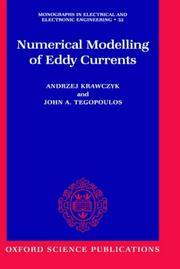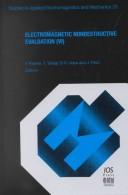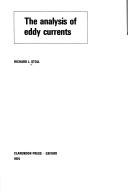| Listing 1 - 10 of 10 |
Sort by
|
Book
ISBN: 1504404858 Year: 1969 Publisher: [Place of publication not identified] : IEEE,
Abstract | Keywords | Export | Availability | Bookmark
 Loading...
Loading...Choose an application
- Reference Manager
- EndNote
- RefWorks (Direct export to RefWorks)
Over the years, the isolated-phase bus has received widespread application in connecting the output of generators to step-up transformers. The trend toward generating units of larger capacity has dictated the need for higher rated isolated-phase bus designs. The increased losses associated with the higher capacity bus may be significant in the economic evaluation of alternate schemes or selection of equipment. The bus designer must know the magnitude and distribution of losses in order to keep temperature rises of bus components within the limits specified in USA Standard C37.20. In addition, the losses must be known to permit proper sizing of forced-cooling equipment whenever it is used.Various papers have been presented that deal with the determination of losses in isolated-phase bus enclosures. The difference in the results obtained for the same bus using various methods is of sufficient magnitude to cause concern. The industry has indicated the need for a guide for calculating losses to establish a common yardstick for establishing, evaluating, and applying different designs.
Book
ISBN: 1504481704 Year: 2022 Publisher: New York : IEEE,
Abstract | Keywords | Export | Availability | Bookmark
 Loading...
Loading...Choose an application
- Reference Manager
- EndNote
- RefWorks (Direct export to RefWorks)
Practices and requirements for semiconductor power rectifier transformers for dedicated loads rated single-phase 100 kW and above and three-phase 100 kW and above are included. Static precipitators, high-voltage converters for dc power transmission, and other nonlinear loads are excluded. Service conditions, both usual and unusual, are specified, or other standards are referenced as appropriate. Routine tests are specified, and an informative annex provides several examples of load loss calculations for transformers when subjected to nonsinusoidal currents, based on calculations provided in the standard.
Book
ISBN: 1523121106 1785612166 Year: 2019 Publisher: London : The Institution of Engineering and Technology,
Abstract | Keywords | Export | Availability | Bookmark
 Loading...
Loading...Choose an application
- Reference Manager
- EndNote
- RefWorks (Direct export to RefWorks)
The book, consisting of 6 chapters, studies motion-induced eddy current techniques for non-destructive testing and evaluation by considering: forward simulation methods; sensors for MIECT; experiments and LET measurements; Lorentz force evaluation and non-destructive applications.

ISBN: 0198593821 Year: 1993 Publisher: Oxford ; New York, NY ; Tokyo : Oxford science publications,
Abstract | Keywords | Export | Availability | Bookmark
 Loading...
Loading...Choose an application
- Reference Manager
- EndNote
- RefWorks (Direct export to RefWorks)
Eddy currents (Electric) --- -Electric currents --- Mathematical models --- Mathematical models. --- -Mathematical models --- Electric currents
Book
Year: 1933 Publisher: Paris : J.-B. Baillière,
Abstract | Keywords | Export | Availability | Bookmark
 Loading...
Loading...Choose an application
- Reference Manager
- EndNote
- RefWorks (Direct export to RefWorks)
Foucault, Courants de --- Courants électriques --- Eddy currents (Electric) --- Electric currents --- Courants électriques
Book
Year: 1944 Publisher: Paris : Gauthier-Villars,
Abstract | Keywords | Export | Availability | Bookmark
 Loading...
Loading...Choose an application
- Reference Manager
- EndNote
- RefWorks (Direct export to RefWorks)
Foucault, Courants de --- Fours à induction --- Eddy currents (Electric) --- Induction furnaces --- Fours à induction

ISBN: 1586032453 4274905055 9781586032456 9784274905056 1417511443 9781417511440 9781601294234 1601294239 6610505470 9786610505470 1280505478 9781280505478 6000004141 9786000004149 Year: 2002 Publisher: Amsterdam Washington, DC Tokyo IOS Press Ohmsha
Abstract | Keywords | Export | Availability | Bookmark
 Loading...
Loading...Choose an application
- Reference Manager
- EndNote
- RefWorks (Direct export to RefWorks)
This work is a collection of papers on electromagnetic nondestructive evaluation. It discusses developments in the growing field of electromagnetic nondestructive evaluation methods. Topics include evaluation of degradation mechanism in magnetic materials.

ISBN: 0198593112 9780198593119 Year: 1974 Publisher: Oxford Clarendon Press
Abstract | Keywords | Export | Availability | Bookmark
 Loading...
Loading...Choose an application
- Reference Manager
- EndNote
- RefWorks (Direct export to RefWorks)
Electromagnetism. Ferromagnetism --- Eddy currents (Electric) --- 621.3.014.4 --- Electric currents --- Eddy currents --- 621.3.014.4 Eddy currents --- Foucault, Courants de
Book
ISBN: 9400702019 9400702027 Year: 2014 Publisher: Dordrecht : Springer Netherlands : Imprint: Springer,
Abstract | Keywords | Export | Availability | Bookmark
 Loading...
Loading...Choose an application
- Reference Manager
- EndNote
- RefWorks (Direct export to RefWorks)
This monograph addresses fundamental aspects of mathematical modeling and numerical solution methods of electromagnetic problems involving low frequencies, i.e. magnetostatic and eddy current problems which are rarely presented in the applied mathematics literature. In the first part, the authors introduce the mathematical models in a realistic context in view of their use for industrial applications. Several geometric configurations of electric conductors leading to different mathematical models are carefully derived and analyzed, and numerical methods for the solution of the obtained problems are given. Related issues such as convergence of the approximations and error estimates are discussed. The second part of the monograph presents various coupled problems that involve eddy current or magnetostatic problems, in particular magneto-hydrodynamic problems and magnetic shaping problems concerning the melt flow of electrically conducting metals, induction heating processes, inductively coupled plasmas and ferromagnetic screening modeling. The presentation of each model comes with numerical illustration from industrial applications.
Eddy currents (Electric) --- Harmonic analysis. --- Time-series analysis. --- Mathematical models. --- Eddy currents (Electric) -- Mathematical models. --- Mathematics. --- Computer mathematics. --- Physics. --- Applied mathematics. --- Engineering mathematics. --- Computational Science and Engineering. --- Numerical and Computational Physics. --- Appl.Mathematics/Computational Methods of Engineering. --- Analysis of time series --- Autocorrelation (Statistics) --- Harmonic analysis --- Mathematical statistics --- Probabilities --- Analysis (Mathematics) --- Functions, Potential --- Potential functions --- Banach algebras --- Calculus --- Mathematical analysis --- Mathematics --- Bessel functions --- Fourier series --- Harmonic functions --- Time-series analysis --- Electric currents --- Computer science. --- Numerical and Computational Physics, Simulation. --- Mathematical and Computational Engineering. --- Engineering --- Engineering analysis --- Informatics --- Science --- Natural philosophy --- Philosophy, Natural --- Physical sciences --- Dynamics --- Computer mathematics --- Electronic data processing
Book
ISBN: 8847055849 8847015057 9786613003218 8847015065 128300321X Year: 2010 Publisher: Milano ; New York : Springer-Verlag Milan,
Abstract | Keywords | Export | Availability | Bookmark
 Loading...
Loading...Choose an application
- Reference Manager
- EndNote
- RefWorks (Direct export to RefWorks)
This book deals with the mathematical analysis and the numerical approximation of time-harmonic eddy current problems. It is self-contained and suitable for mathematicians and engineers working in the field, and also accessible for beginners. Depending on the choice of the physical unknowns, these problems are formulated in different variational ways, with specific attention to the topology of the computational domain. Finite elements of nodal or edge type are used for numerical approximation, and a complete analysis of convergence is performed. A specific feature of the book is the emphasis given to saddle-point formulations in terms of the magnetic and electric fields. New results for voltage or current intensity excitation problems are also presented.
Eddy currents (Electric) -- Mathematical models. --- Harmonic analysis. --- Time-series analysis. --- Eddy currents (Electric) --- Harmonic analysis --- Time-series analysis --- Mathematics --- Physics --- Electrical & Computer Engineering --- Physical Sciences & Mathematics --- Engineering & Applied Sciences --- Electricity & Magnetism --- Mathematics - General --- Electrical Engineering --- Mathematical models --- Maxwell equations. --- Differential equations, Partial. --- Computer science --- Mathematics. --- Computer mathematics --- Discrete mathematics --- Electronic data processing --- Partial differential equations --- Equations, Maxwell --- Mathematical analysis. --- Analysis (Mathematics). --- Partial differential equations. --- Computer mathematics. --- Mathematical models. --- Analysis. --- Computational Mathematics and Numerical Analysis. --- Partial Differential Equations. --- Mathematical Modeling and Industrial Mathematics. --- Mathematics, general. --- Models, Mathematical --- Simulation methods --- 517.1 Mathematical analysis --- Mathematical analysis --- Math --- Science --- Differential equations, Partial --- Electromagnetic theory --- Global analysis (Mathematics). --- Differential equations, partial. --- Analysis, Global (Mathematics) --- Differential topology --- Functions of complex variables --- Geometry, Algebraic
| Listing 1 - 10 of 10 |
Sort by
|

 Search
Search Feedback
Feedback About UniCat
About UniCat  Help
Help News
News